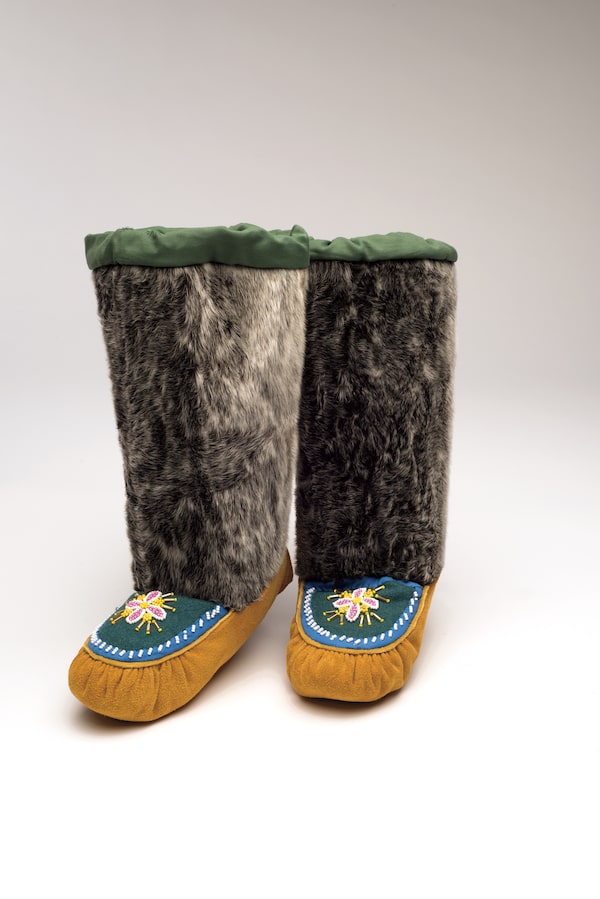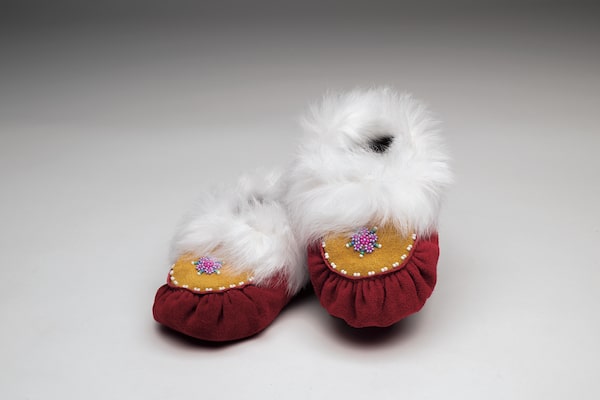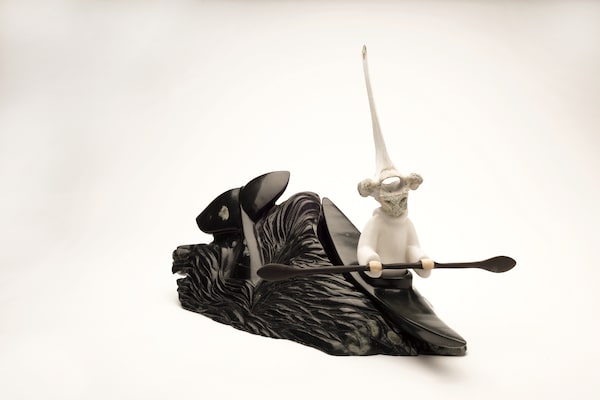
Jason Sikoak’s large-scale pen and ink drawing Sacrilege (2015), is one of the final pieces in the show. It is the largest work Sikoak has made to date, and earned him an instant commission from a Toronto woman.Collection of Jason Shiwak
Heather Igloliorte, on her way to becoming the first (and only, to date) Inuk holder of a PhD in art history in Canada, was looking to write about artists from Nunatsiavut – the northern coastal area of Labrador. An artist herself from Happy Valley-Goose Bay, Igloliorte had suffered a serious, career-stalling car accident (traffic lights were out in Halifax after Hurricane Juan). So she was taking time out from her art practice to study art history. For her master’s degree, she planned to write about artists from Nunatsiavut, which achieved self-government in 2005.
But a funny thing happened on the way to her thesis: She could find very little information about Nunatsiavummiut art or artists.
“It was really shocking to me that there were almost no exhibition catalogues, there were no books on Labrador Inuit art, there were just a handful of articles and magazine essays and so on,” says Igloliorte, who is the Concordia University Research Chair in Indigenous Art History and Community Engagement. “And it was really surprising. I did not anticipate not finding things because I knew so many artists in Labrador.”
So she began digging into what would become her PhD project. Ultimately, her efforts grew into a large exhibition and accompanying catalogue, SakKijajuk: Art and Craft from Nunatsiavut.
“How often do you get to create an exhibition that is from a group of artists that no one has ever heard of before?” Igloliorte says.

Josephina Kalleo’s Working. Her drawings, along with the oral history she recorded for each image, are considered to be among the best descriptions of transitional Labrador Inuit life during the mid-20th century.The Rooms Provincial Art Gallery, Memorial University Collection
SakKijajuk, originally installed at The Rooms Provincial Art Gallery in St. John’s before moving to the Art Gallery of Nova Scotia, has now opened at the Winnipeg Art Gallery – coinciding with the WAG’s groundbreaking for its Inuit Art Centre.
Nunatsiavut is the smallest of the four Inuit regions and the only one that is self-governing. There are five communities in the region – Nain, Hopedale, Makkovik, Postville and Rigolet – and two outside with large populations of Nunatsiavummiut, Happy Valley-Goose Bay and North West River.
WAG director Stephen Borys says Nunatsiavut is perhaps the least represented in the WAG’s extensive Inuit art collection (of more than 13,000 works), “and sometimes the least understood in terms of art-making” in general, he says.

Andrea Flowers’s Boots (2015).Artist's collection
The reason Nunatsiavummiut artists have been largely excluded from the canon of Inuit and Canadian art history has nothing to do with their work and everything to do with geography – and politics. In brief, Labrador Inuit artists have been making work and trading with Europeans for centuries, so these objects can be found in museum collections around the world. When Newfoundland joined Confederation in 1949, the final Terms of Union failed to mention Indigenous peoples. As an (unintended) consequence, the artists were not eligible for federally funded Inuit art initiatives. Nor were they allowed to use the “Igloo” tag, denoting authentic Inuit art, until 1990. So at the same time that exposure and study of and demand for Inuit art was exploding into a multimillion-dollar industry, Nunatsiavummiut artists remained virtually invisible.
So this show is much more than an art exhibition; it’s a righting of history.
“It’s a nice breakthrough,” says Happy Valley-Goose Bay artist Michael Massie, one of the artists in the show. “It’s definitely deserved. We were never recognized.”
SakKijajuk – which means “to be visible” in Inuttitut, the Labrador dialect of Inuktitut – includes nearly 90 works from 47 artists, divided into four categories. Elders, Trailblazers, Fire Keepers and The Next Generation may be artists many Canadians have never heard of, but this is art Canadians need to see.
“Canada is huge and the North right now is politically sensitive in terms of natural resources, sovereignty, the environment, water,” Borys says. “All those things come out in the artwork because art is political.”
The show
The exhibition opens with a powerful installation that speaks to the history of the region, Our Footprints Are Everywhere. That was the title of a landmark 1977 Labrador Inuit Association report that was instrumental in the successful land claim and the formation of Nunatsiavut. The installation is made up of a series of boots (or kamek) by different artists and one pair of moose-hide baby slippers.
“The reason we were able to establish our land claim is literally because our footprints were everywhere,” Igloliorte says. “Being able to reference [that] we have travelled all over this part of the land – that was instrumental in us getting our land claim.

Vanessa Flowers’s Baby Slippers (2015).Artist's collection
“The boots are speaking about how we travel on our land,” she continues. “But then also it speaks very significantly to the transmission of knowledge, intergenerationally. Everyone who has a pair of kamek there learned from someone else in their family or they were passing it down, the skills, in that process.”
The first pair, made from beaver fur, moose hide, wool and beads, is credited to Inez Shiwak and Jane Shiwak, her mother.
“Inez insisted that her mother be given credit for the collaboration on those boots, not because her mother did much of the sewing on those boots, but because her mother’s knowledge was so integral,” Igloliorte says.
In another series of works, Josephina Kalleo (1920-1993), one of the earliest artists to gain recognition in the region, drew scenes from her life on paper, which she then attached to standard-issue, letter-sized beige office file folders. As part of her job, she had been translating an elder’s life story from Inuktitut into English. And while transcribing his story, she became inspired to tell her own. These drawings, along with the oral history she recorded for each image, are considered one of the best descriptions of transitional Labrador Inuit life during the mid-20th century.
The show, which includes many contemporary works, is not all drawings, sealskin and whalebone; the artists work with materials and media that one might not associate with traditional Inuit art – photography, video, oil paint. But historically, particularly for sculptors from this region – some living below the tree line – using out-of-the-box materials has been another obstacle to recognition.

Michael Massie’s Boa (1996), a silver, ivory and wood teapot.The Rooms Provincial Art Gallery, Memorial University Collection
When a photo of artist Michael Massie’s silver ulu bowl was printed in an issue of Inuit Art Quarterly in the 1990s, just a tiny little photo in a corner of a page, there was an uproar; collectors, dealers and art historians protested and the magazine was deluged with angry mail.
“It’s crazy to think that as early as two or three decades ago, the art world would have imposed such strict standards on Inuit art as to say stone is Inuit and metal is not or wood is not,” Igloliorte says. “That is the history of Inuit art – of rules being imposed from outside. And then Inuit artists having to break through those barriers. So Mike is a trailblazer in that sense.”
Massie has five works in this show, including a silver, ivory and wood teapot from 1996. He is now probably best known and widely celebrated for his teapots, but they were also initially rejected as “real” Inuit art by people operating in that world.
“It was just thrilling to be a stink-maker, causing stink,” Massie says about that tempest over his teapots. “I loved it.”

Billy Gauthier’s Song from the Spirit World.Grenfell Campus, Memorial University collection
Another well-known sculptor in the show is Billy Gauthier, who made headlines when he went on a hunger strike to protest against the Muskrat Falls hydroelectric project on the lower Churchill River.
The detail in Gauthier’s work is breathtaking; in Song from the Spirit World, the gestures of his sculpture take their cues from his material, which include caribou and moose antler; his drum dancer’s gestures follow the shapes provided by nature. The sinuous figure almost seems to be in motion, right down to his elegant, elongated hands.
Impact on artists
Igloliorte found her artists by travelling to communities in Labrador, getting on the radio in the morning and encouraging artists to come out and meet with her that day.
After she completed her PhD, she returned to Labrador, seeking input from the artists themselves – what did they want to do next? Through those conversations, the idea for an exhibition emerged.
First, she organized a community exhibition – whoever wanted to be in the show would be included and could submit up to three things. The show was held at the Kinsmen Community Centre in Happy Valley-Goose Bay, where temporary walls were built and draping covered the dart board. The show featured more than 170 works by nearly 100 artists; about a quarter of those artists ended up in this touring exhibition.
For Nunatsiavut art, SakKijajuk is seminal. And for some of the individual artists, it has been nothing short of life-changing.

Jason Jacque’s Shaman (2015).
Jason Jacque, from tiny Postville, has a serpentinite, wood, marble and bone sculpture, Shaman (2015), in the exhibition. The sculpture of a Shaman riding a wave is whimsical and complex; clearly the work of a skilled carver. And yet, Igloliorte reports, Jacque had never sold a piece before the show; he had only made artwork as gifts. Now, The Rooms has purchased Shaman and he has taken a leave of absence from his day job to study jewellery-making full-time; Igloliorte wrote his reference letter.
One of the final pieces in the show is a haunting, large-scale pen and ink drawing, Sacrilege (2015) – in which an Inuk man finds himself caught between two worlds – the one he knows and the invading colonialism. In front of him is a shaman; there is a tiny herd of caribou emerging from his beak-like mouth, and an upside-down cross. Standing behind the man is a Bible-toting missionary, trying to draw him back with a string of rosary beads. The man, clinging to his dogsled, looks out at the viewer, terrified.
It’s the largest work Rigolet artist Jason Sikoak had made to date and it earned him an instant commission from a Toronto woman who saw Sacrilege at the opening in St. John’s.
“What’s amazing is Jason was so ignited by this process,” Igloliorte says. “He’s now going to art school. He’s changing his career and deciding to pursue being an artist full-time.”
SakKijajuk is at the Winnipeg Art Gallery until Oct. 14. From there, the exhibit will travel to the MacKenzie Art Gallery in Regina (Feb. 14-June 2, 2019) and the Art Gallery of Windsor (Oct. 19, 2019-Jan. 26, 2020).
 Marsha Lederman
Marsha Lederman